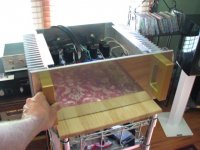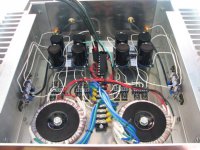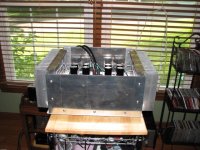For the 5 watt F5, I may try messing with it this and next weekend.
I may try it with IRF510 and IRF9510, other semi's stay the same. All resistors and bias points need to be changed too. Any good suggestions?
I may try it with IRF510 and IRF9510, other semi's stay the same. All resistors and bias points need to be changed too. Any good suggestions?
Does one to have adjust some resistors for the current limiting transistors?
R17/R19 and R18/R20 will be O.K. as long as we bias also with about 1.3A.
But R21 and R22?
Franz
R17/R19 and R18/R20 will be O.K. as long as we bias also with about 1.3A.
But R21 and R22?
Franz
if you're going to make Mini F5 - just toss out current limiting parts
Agree... However, I may still keep the NTC thermistors to minimize thermal drift.
NTCs aren't part of current limiting 😉
No, they are not. I had seen a simplified F5 circuit posted some times ago that NTCs and current limiting parts were all tossed out. That's why I wanted to stress that.
Last edited:
Yes it would. Tie two batteries in series and point of connection is your new ground, like this:
Hi Juma,
I was seriously considering doing this, but the following post made me think twice.
You could do that,BUT,you will have to consider the 'ground' points for the rest of the system.
Often RE battery banks are grounded at the negative end (0V),if you tap the center of the bank and use that as the amp ground,then the 'ground' of the amp will be floating at 1/2 of the battery bank voltage. If you were to connect the amp,to say,a preamp that's grounded at 0V,you're gonna have 1/2 of the battery bank voltage flowing through your interconnects! And we all know BIG batteries can supply BIG currents.
Just be sure to consider all of the current paths,before you start connecting things together. 😉
that means nothing else than - that ground is state of mind .....
meaning - you must know what are you doing ...... and stand sometimes out of the box ;
DJ wrote nothing else ..... than just that .
Juma's advice is valid , as usual .
meaning - you must know what are you doing ...... and stand sometimes out of the box ;
DJ wrote nothing else ..... than just that .
Juma's advice is valid , as usual .
maybe worth to note that original 8watt Monster uses both "ordinary" power supply and batteries
I suppose that batteries alone would be drained very quick
another problem with big starter batteries is that they will be hurt and age faster if loaded when not fully charged
thats why the are called starter battery
one option could the kind of battery used in small battery driven trucks
totally different beast
btw, I have seen a simple and cheap switchmode supply with built in battery charger
intended fore PC with security backup supply
I suppose that batteries alone would be drained very quick
another problem with big starter batteries is that they will be hurt and age faster if loaded when not fully charged
thats why the are called starter battery
one option could the kind of battery used in small battery driven trucks
totally different beast
btw, I have seen a simple and cheap switchmode supply with built in battery charger
intended fore PC with security backup supply
AC Delco deep cycle batteries have been used for decades in yachts before automobiles caught up.
These batteries survive total drainage several times before they kick the bucket.
These batteries survive total drainage several times before they kick the bucket.
you must know what are you doing ......
Which, of course, I don't. My kung-fu is not very strong. No disrespect meant to audio black belt Juma.
maybe worth to note that original 8watt Monster uses both "ordinary" power supply and batteries
This is what I'd ultimately like to do. Run the amp on the mains to warm up, then on marine deep-cycle batteries for serious listening.
a phono amp on batteries might make sense....or small classD
but to have any real effect I think you need to isolate all your components from the mains
mind you, Nelsons original F5 is on top of things, using just plain ordinary power supply 😉
but to have any real effect I think you need to isolate all your components from the mains
mind you, Nelsons original F5 is on top of things, using just plain ordinary power supply 😉
After a slew of questions on the Peter Daniels GB F-5 thread, several here and a few I just randomly asked on the Pass forums, I finally got the amp biased properly with little or no offsett.
Hooked up the B-1 and speakers, re-powered up, let warm until stable, and music indeed came out! Only a couple hours, more and Pics tonight.🙂
Russellc
Hooked up the B-1 and speakers, re-powered up, let warm until stable, and music indeed came out! Only a couple hours, more and Pics tonight.🙂
Russellc
well done.
There must have been a hundred of these things born since I started. I took my time, but everything worked out just as it was supposed to. So far! Really, the thing seems quite stable. Well worth the effort.
russellc
One of the best I've heard period. Cant believe it came from my solder gun!😀
Face plate isnt attached yet and the power cords are temporarily installed. Note that the grounds arent yet attached, and while not safe to leave, I must say this amp is quiet. In the left speaker with your ear right up against a JBL 2235H, a very slight hum is just perceptible. I am over stating to speak of this as a "hum"......you couldnt hear it at all in anything but a dead quiet room, and only with your ear right up next to the driver.
Face plate isnt attached yet and the power cords are temporarily installed. Note that the grounds arent yet attached, and while not safe to leave, I must say this amp is quiet. In the left speaker with your ear right up against a JBL 2235H, a very slight hum is just perceptible. I am over stating to speak of this as a "hum"......you couldnt hear it at all in anything but a dead quiet room, and only with your ear right up next to the driver.
Attachments
Good job.I have an F5 but does not have such a beautiful case.I will build one
It wasnt difficult. Member Westend cut the panels and the angle aluminum to length. He used a regular table saw with a special blade and cut it perfectly just like it was wood. The Sinks (M&M Metals) are drilled and tapped to allow the angle pieces to be attached, which in turn are bolted to the panels with just through holes.
All the panels were mailed to me flat pack style, and without the faceplate, would not weigh much. Panels are 1/8 inch 6061 ( If I remember correctly) aluminum. The tapping and drilling of the heat sink worried me, but was actually one of the simplest things about the build. I just had never done that before.
You could contact Westend, shipping would not be that expensive, and the aluminum is cheap too. I bolted it together with 10-32 screws, diodes and mosfets with 4-40. All you need is the panels, a measure, about 5 drill bits and 2 taps, 10-32 and 4-40. Perhaps you are able to saw metal, I guess I could too if I had a table saw and proper blade.
Russellc
Post pics when finished
- Home
- Amplifiers
- Pass Labs
- F5 power amplifier



